(photo credit: k.sina.com.cn/article_6447152527_p18047bd8f00100gtgk.html?from=cul)
When you’re drawn into the world of Chinese furniture and decoration, there’s this small catch: it’s just impossible to overlook their elaborate details and rich cultural contexts. Oftentimes the design, patterns, colors, or even materials tell a lot of stories about that particular piece.
Unsurprisingly, one of the most popular decorative designs in Chinese tradition is animal, both mythical and real ones, since they are abundant in Chinese folk tales and stories. Here we select a few that often show up on furniture pieces as decorative themes to share their fascinating stories with you!
Dragons (龙): Almost synonymous to the country itself, dragons are extremely auspicious and significant mythical animal in the Chinese culture. Opposite to the villainous, fire-breathing, gold-hoarding ‘worms’ in the West, Chinese dragons almost always have fair and benevolent character.
Their appearance can be a mixture of many animals such as camel’s head and hawk’s claws and etc., but mostly they look like snakes with 4 legs and 2 horns. This description dismisses the 9 sons of dragon which can look more like wolf, tortoise, lion, etc.
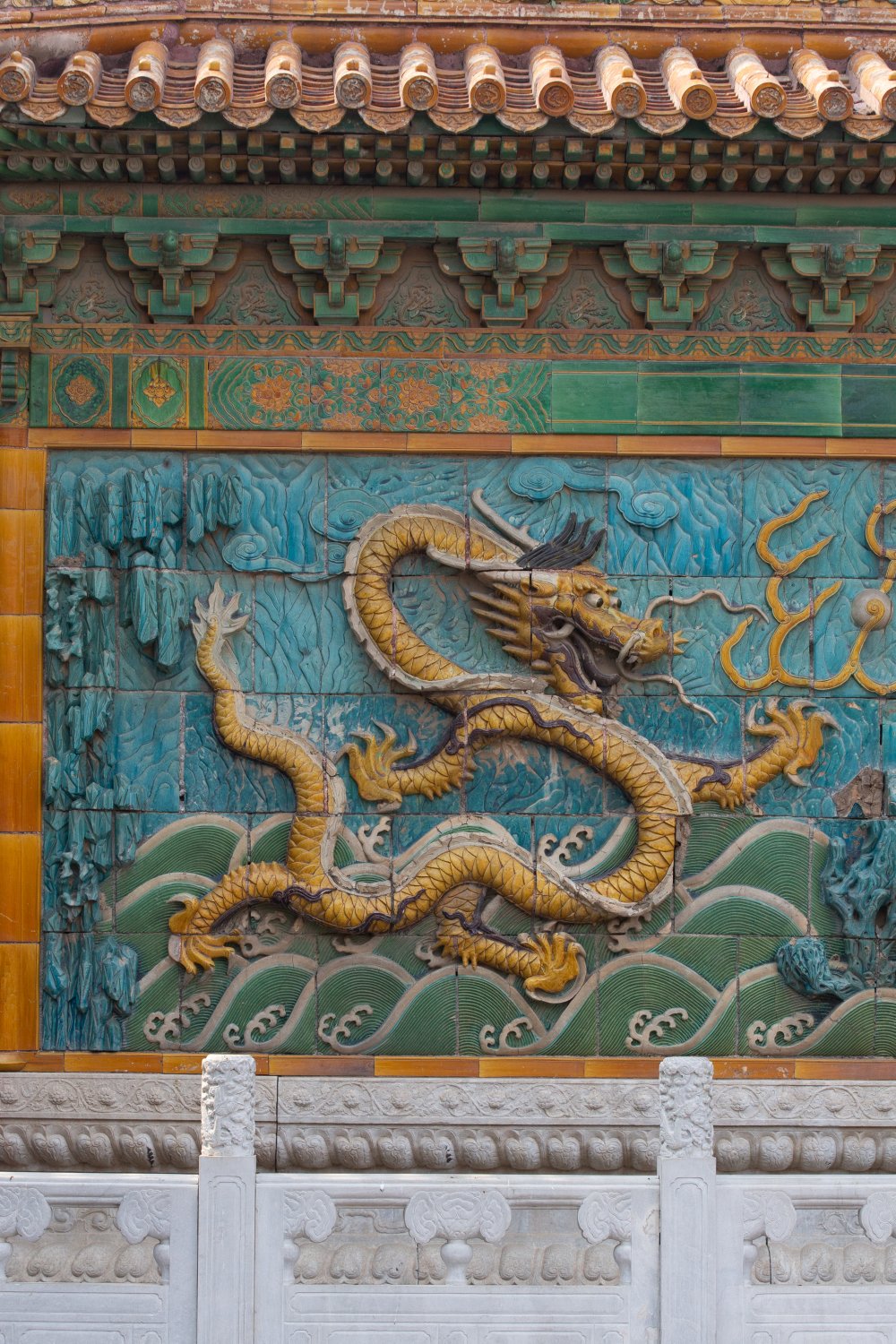 A Section in the Nine-Dragon Screen, the Forbidden City in Beijing (photo credit: www.dpm.org.cn/explore/building/236477.html)
A Section in the Nine-Dragon Screen, the Forbidden City in Beijing (photo credit: www.dpm.org.cn/explore/building/236477.html)
In Chinese myths, dragons are many things: gods, chief of scaled animals, masters of rain, water bodies, cloud, and the lord of the sky in general. They represent power and strength, particularly imperial ones.
Dragon serves as a symbol of Emperor alongside the phoenix as Empress. It’s almost a guarantee to find dragon motifs when you visit former palaces or royal residences in China.
Bonus: if you know a bit Chinese, you would find many proverbs that are related to dragons. And people who are outstanding or excel in something are compared to dragons – the testament of how much dragons are appreciated by the Chinese!
 A Nine-Headed Phoenix from the Classic of Mountains and Seas (photo credit: upload.wikimedia.org/wikipedia/commons/e/e1/Phénix_à_neuf_têtes.png)
A Nine-Headed Phoenix from the Classic of Mountains and Seas (photo credit: upload.wikimedia.org/wikipedia/commons/e/e1/Phénix_à_neuf_têtes.png)
Phoenixes (凤凰): Also quite different from that of the West, this Chinese mythical bird isn’t associated with the rebirth from the ashes concept. Legend has it that this is an auspicious creature which appears only in peaceful, prosperous times and likes to land on the Chinese parasol trees (梧桐wútóng).
In general, phoenix represents grace and great virtues.
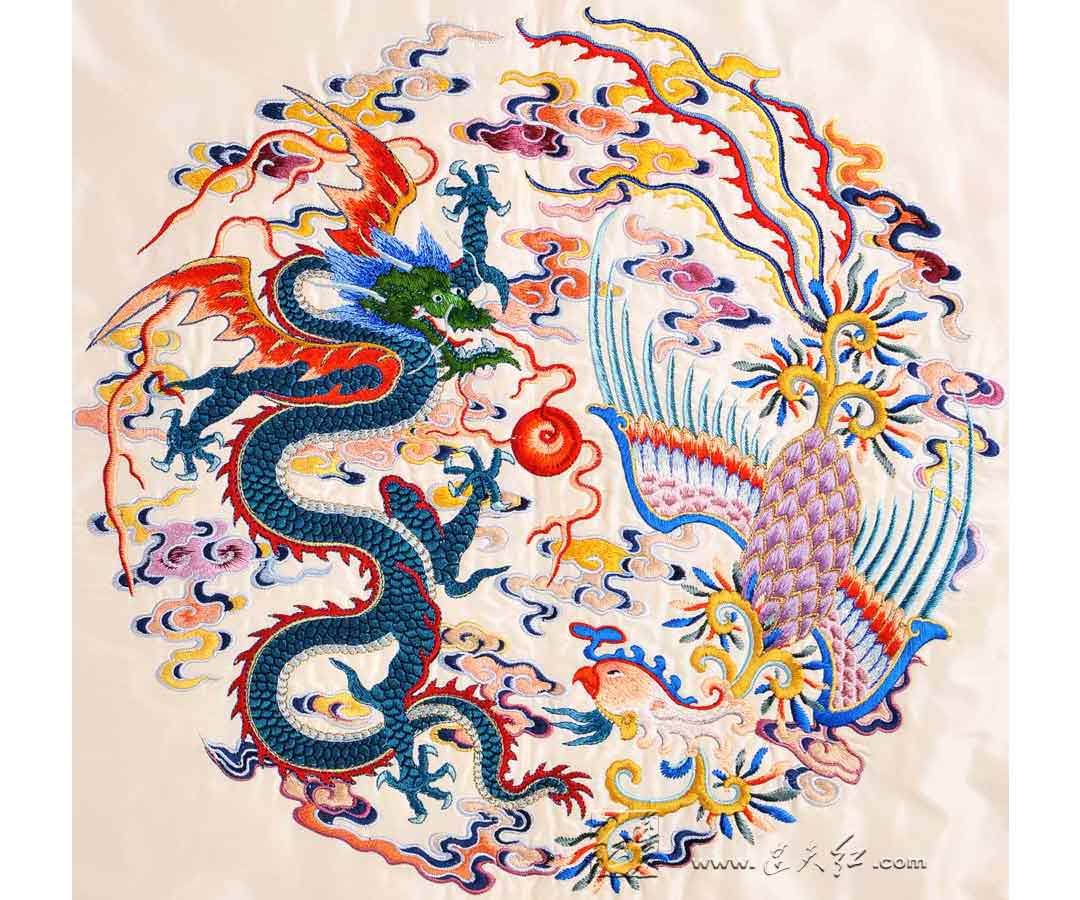 Dragon & Phoenix Embroidery Pattern (photo credit: www.liantianhong.com/html/product/buyi/baozhen/xinpin/78826.html)
Dragon & Phoenix Embroidery Pattern (photo credit: www.liantianhong.com/html/product/buyi/baozhen/xinpin/78826.html)
Actually, its Chinese name凤凰 (fènghuáng) originally referred to the male (凤) and female (凰) birds separately. But at one point, such division was linguistically blurred and the word 凤凰 signifies more femininity today, especially when paired with dragons.
In most cases, phoenixes represent the feminine power, referring to the Empress. Dragon & phoenix motif is often used in weddings to symbolize a blissful union between husband and wife.
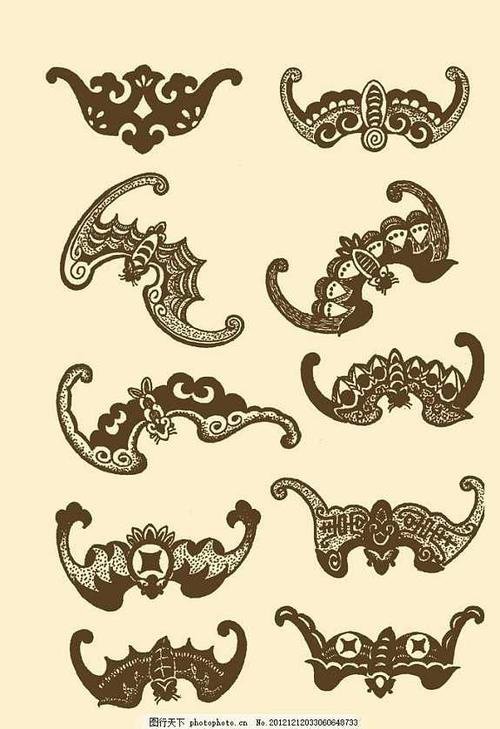 (photo credit: j.17qq.com/article/mqfqspfqy.html) Bats (蝙蝠): Bat, or ‘sky mouse’ (天鼠) has positive connotations in China. The Chinese welcome the creature as auspicious symbol that brings joy and happiness.
(photo credit: j.17qq.com/article/mqfqspfqy.html) Bats (蝙蝠): Bat, or ‘sky mouse’ (天鼠) has positive connotations in China. The Chinese welcome the creature as auspicious symbol that brings joy and happiness. The character ‘蝠’ (fú) in its Chinese name is homophone with ‘福’ (prosperity), hence the association. As such the image of bats is commonly shown to display blessings for good luck, fortune, and happiness.
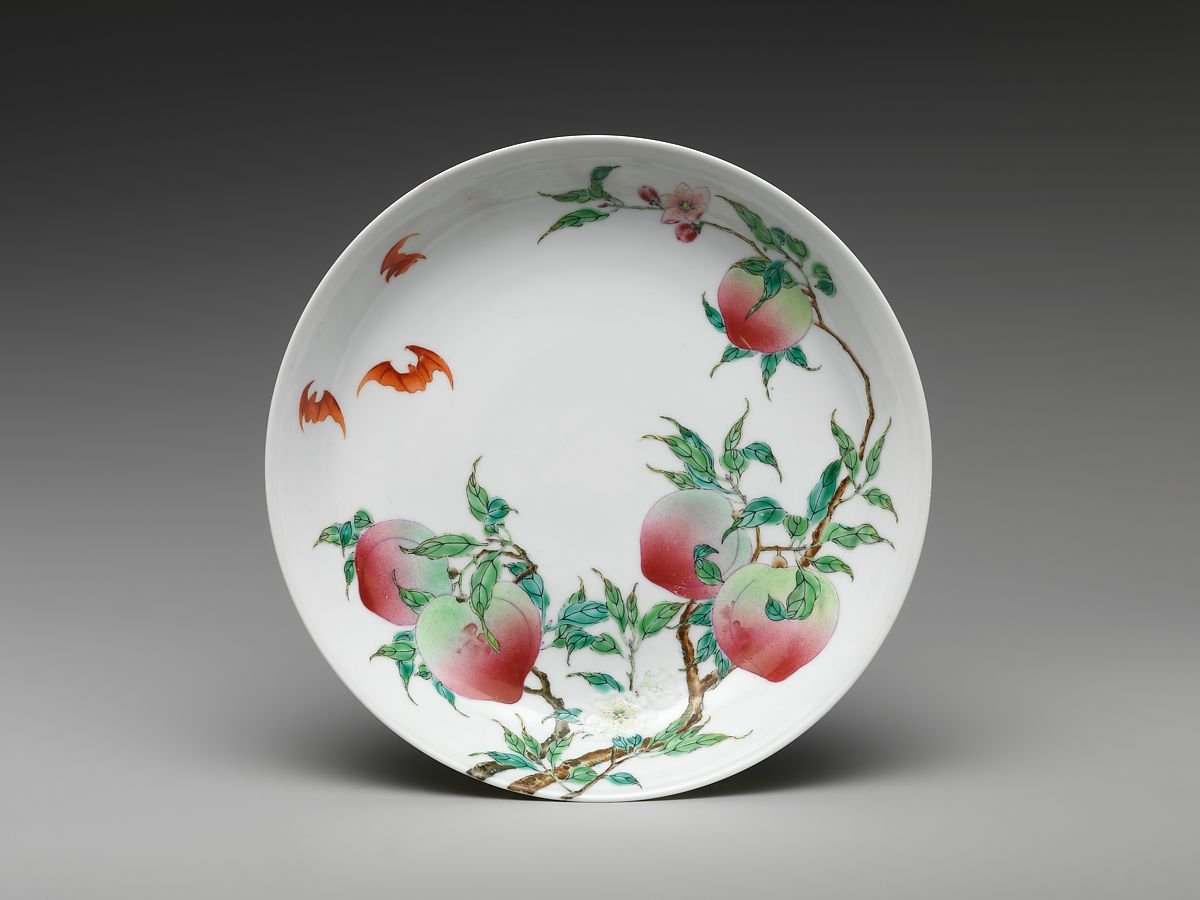 Dish with Peaches and Bats from 18th Century (photo credit: www.metmuseum.org/art/collection/search/39532)
Dish with Peaches and Bats from 18th Century (photo credit: www.metmuseum.org/art/collection/search/39532)
Different combinations also have different meanings. For example, two bats often signify double fortune (双福); five bats refer to the five blessings of life (longevity, wealth, health & composure, love of virtue, and the desire for a natural, peaceful death) often surrounded the character ‘寿’ (longevity); while bats combined with peaches symbolize auspicious wishes for longevity.
 Double Butterflies with Chrysanthemums from the Book of Silk Tapestry (photo credit: chinese.efreenews.com/a/huayishixin-juhua-zhenxiuxinxiangshuangxiajie?lang=gb)
Double Butterflies with Chrysanthemums from the Book of Silk Tapestry (photo credit: chinese.efreenews.com/a/huayishixin-juhua-zhenxiuxinxiangshuangxiajie?lang=gb)
Butterflies (蝴蝶): Not strictly animal, but this naturally delicate creature surely allows Chinese people’s imagination to roam a lot.
Most of the times, butterflies are seen as a symbol of love, marriage, and eternal bond between lovers.
If you’re familiar with the legend of Liang Sanbo and Zhu Yingtai (梁山伯与祝英台) or the Butterfly Lovers, the symbolic meaning of butterflies would seem clear in an instant since the story is widely known in the West as the Chinese Romeo and Juliet.
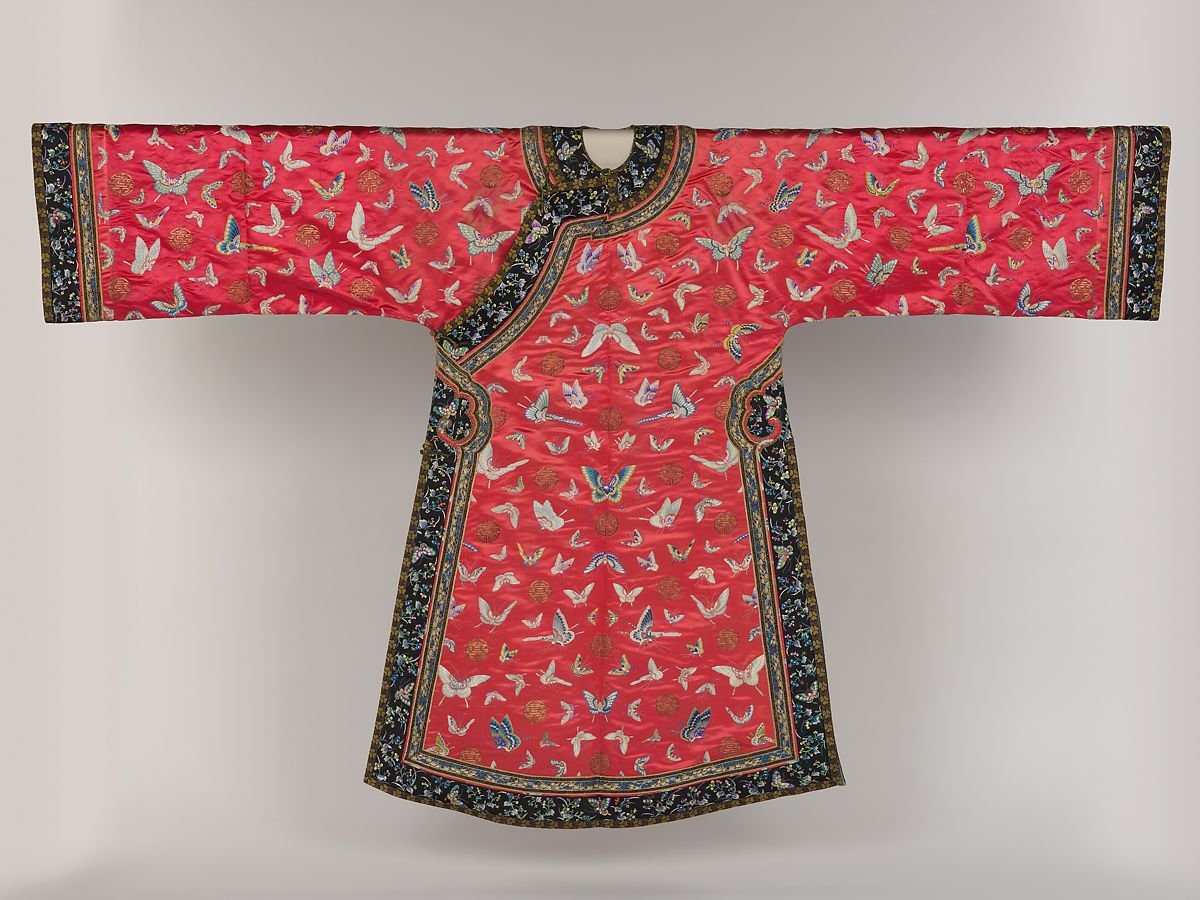 Woman’s Robe with Butterfly Pattern (photo credit: www.metmuseum.org/art/collection/search/70499)
Woman’s Robe with Butterfly Pattern (photo credit: www.metmuseum.org/art/collection/search/70499)
When paired flowers, the image of butterflies often represent the quest for sweet love and a blissful marriage, especially with plum blossoms.
So butterfly motifs are generally displayed in joyous occasions like weddings.
On the other hand, the character ‘蝶’ (dié) in the word ‘butterfly’ is homophone with ‘耋’ (to be in an age of 70-80), so butterflies also represent longevity and associated with celebrations for the elderly.
These symbolic animals are not only found on furniture pieces and decorations, but also in architectural and other product designs. For us at Yesterday Once Again, we treat and take care of our products as something that will become our clients’ treasure.
Knowing the meanings behind these symbolic creatures allows us to be more appreciative of the pieces in our hands, as we get to learn their stories and find the right home for them.







